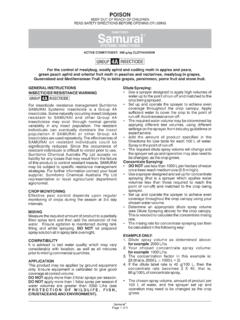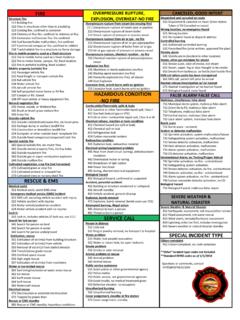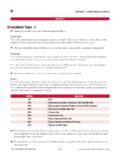Transcription of Legend Fungicide label - Pest Genie - Farm …
1 READ SAFETY DIRECTIONS BEFORE OPENING OR USINGDow AgroSciences Australia Limited ABN 24 003 771 65920 Rodborough Road FRENCHS FOREST NSW 2086 SERVICE TOLL FREE 1-800 700 096 Trademark of The Dow Chemical Company ( Dow ) or an affiliated company of DowLegend FungicideACTIVE CONSTITUENT: 250 g/L QUINOXYFENFor use as a protectant against powdery mildew in grapevines and barley crops as specified by the Directions for FOR USERESTRAINTSDO NOT spray if rain is likely within one (1) NOT apply with DRIFT RESTRAINTSE xcept when applying with orchard/vineyard airblast equipment, DO NOT apply with spray droplets smaller than a MEDIUM spray droplet size category according to nozzle manufacturer specifications that refer to the ASAE S572 Standard or the British Crop Production Council NOT apply when wind speed is less than 3 or more than 20 kilometres per hour, as measured at the application NOT apply during surface temperature inversion conditions at the applications of this product MUST make an accurate written record of the details of each spray application within 24 hours following application, and must KEEP this record for at least two (2)
2 Years. The spray application details that must be recorded are:1. date with start and finish times of application 2. location address and paddock(s) sprayed 3. full name of this product 4. amount of product used per hectare and number of hectares applied to 5. crop or situation and weed or pest 6. wind speed and direction during application 7. air temperature and relative humidity during application 8. nozzle brand, type, spray angle, nozzle capacity and spray system pressure measured during application 9. name and address of person applying this product. (Additional record details may be required by the state or territory where this product is used.)CROPDISEASERATECRITICAL COMMENTSG rapesPowdery mildew (Uncinula necator)Dilute Spraying: 10 - 20 mL/100 L waterDO NOT use more than three (3) applications to any vine crop in one as a protectant treatment Fungicide has no curative activity and does not control existing infection (powdery mildew between infection and visible stage).
3 Use 10 mL rate as part of a protectant spray program. Retreat every 7-10 days as necessary. Use 20 mL rate during periods when high or sustained infection pressure is expected. Retreat every 10-14 days as by dilute or concentrate spraying equipment. Apply the same total amount of product to the vines whether applied by either method. Concentrate Spraying: Refer to the Mixing/Application SectionBarleyPowdery mildew (Blumeria graminis )200 - 300 mL/haDO NOT apply more than two (2) applications to any barley crop in one season. DO NOT apply after barley growth stage Fungicide should be applied at the first sign of infection as a protectant treatment only. Monitor barley crops regularly from early tillering and apply at or before if conditions favour disease development and reapply from 21 to 28 days after the first application and no later than at the higher rates where conditions favour severe disease Fungicide will only be effective on powdery mildew in barley.
4 If other diseases are suspected or detected then apply with the label rate of PropiMax Fungicide is a foliar applied protectant Fungicide that only has preventative properties. The protectant activity demonstrated by Legend Fungicide when applied to plant foliage is primarily by volatilisation and reabsorption onto new, untreated plant material. Protection is not limited to the leaf to which it is applied. Legend Fungicide is strongly bound to leaf waxes and therefore not easily washed off the foliage by rain if allowed to dry after TO BE USED FOR ANY PURPOSE, OR IN ANY MANNER, CONTRARY TO THIS label UNLESS AUTHORISED UNDER APPROPRIATE INSTRUCTIONSMIXINGP rior to adding to the tank, agitate or shake the container vigorously then follow the mixing instructions tank mixing with other products, the following order is recommended:1. Quarter fill the spray tank maintaining Add any wettable powders or dry flowable formulations with continuous agitation, ensure product is completely Add Legend Add water to half fill the spray Add emulsifiable concentrates or soluble liquids, with continuous If Uptake Spraying Oil is to be used, add when spray tank is three quarters Add water to bring to the final spray mix sufficient spray solution for immediate use and avoid OF DILUTED SPRAY MIXW henever possible use the spray mix immediately after it is prepared.
5 However if undesirable weather conditions or mechanical breakdown occur, the stored spray mix may be used up to six (6) hours after initial mixing. Ensure regular agitation by mechanical or hydraulic action to thoroughly remix every three (3) TO GRAPESFor volumes of, or greater than, 1000 L/ha, use the dilute spray rate. If volume to be applied is less than 1000 L/ha then use the concentrate spraying application method. Application volume will vary with vine growth stage, canopy density, pruning regime and crop vigour. For best results follow the recommendations SPRAYING APPLICATIONUse a sprayer designed to apply high volumes of water up to the point of run-off and matched to the crop being up and operate the sprayer to achieve even coverage throughout the crop canopy. Apply sufficient water to cover the crop to the point of first run-off. Avoid excessive required water volume may be determined by applying different test volumes, using different settings on the sprayer, from industry guidelines or expert the amount of product specified in the DIRECTIONS FOR USE table for each 100 L of water in the tank.
6 Spray to the point of required dilute spray volume will change and the sprayer set up and operation may also need to be changed, as the crop coverage of the grapevines and bunches is SPRAYING APPLICATIONUse a sprayer designed and set up for concentrate spraying (that is, a sprayer which applies water volumes less than those required to reach the point of run-off) and matched to the crop being sprayed. Set up and operate the sprayer to achieve even coverage throughout the crop canopy using your chosen water an appropriate dilute spray volume (see DILUTE SPRAYING above) for the crop canopy. Consult your local advisor, agronomist or Department of Primary Industries to determine this volume. This is needed to calculate the concentrate mixing PERIODG rapes: DO NOT HARVEST FOR 14 DAYS AFTER : NOT REQUIRED WHEN USED AS FOOD WITHHOLDING PERIODG rapes: NOT REQUIRED WHEN USED AS : DO NOT GRAZE OR CUT FOR STOCK FOOD FOR 28 DAYS AFTER DESTINED FOR EXPORT MARKETSThe grazing withholding period only applies to stock slaughtered for the domestic market.
7 Some export markets apply different standards. To meet these standards, ensure that in addition to complying with the grazing withholding period the Export Slaughter Interval is observed before stock are sold or SLAUGHTER INTERVAL (ESI) 14 daysAfter observing the withholding period for grazing or cutting for stock food, livestock that have been grazed on or fed treated crops should be placed on clean feed for 14 days prior to FOR EXPORT WINER efer to AWRI OF TREATED GRAPEST able grape growers should note that suitable MRLs or import tolerances may not be established in all markets for table grapes treated with Legend Fungicide . If you are growing table grapes for export, please check with Dow AgroSciences for the latest information on MRLs and export tolerances before using Legend overThe mixing rate for concentrate spraying can then be calculated in the following way:Example Only1.
8 Dilute spray volume as determined above: For example, 1500 L/ha2. Your chosen concentrate spray volume: For example, 500 L/ha3. The concentration factor in this example is: 3 x (ie, 1500 L/500 L = 3)4. If the dilute label rate is 10 mL/100 L (low Legend rate), then the concentrate rate becomes 3 x 10, ie 30 mL/100 L of concentrate chosen spray volume, amount of product per 100 L of water and the sprayer set up and operation may need to be changed as the crop further information on concentrate spraying, users are advised to consult relevant industry guidelines, undertake appropriate competency training and follow industry Best CANOPY ROW (UCR) APPLICATIONA nother method for determining the amount of product to spray is called the unit canopy row method. This method is not based on planted area (rate/ha) or row spacing but considers the width and height of the foliage to determine the appropriate volume to apply either as a dilute spray or a concentrate spray.
9 The applied volume per hectare increases as row spacings become smaller and canopy sizes increase. This method of application is described in a Fact Sheet (Agdex 210/744, June 2000 by Geoff Furness and Peter Magarey) obtainable from SARDI Loxton Centre. For further information on how to apply this method, contact your local advisor, department of agriculture staff, the factsheet above or the SPRAY APPLICATION TO BARLEYA pply Legend Fungicide in sufficient water to obtain good coverage. It should be applied by an accurately calibrated ground rig using a water volume of 50 100 L/ha. Sprayers should apply a MEDIUM spray quality in accordance with ASAE standard Fungicide is NOT compatible with fungicides containing fosetyl as the aluminium salt. However Legend Fungicide is compatible with a range of products as follows:Insecticides Lorsban 750 Pyridaben and Amistar , chlorothalonil, copper hydroxide, copper oxychloride, dithianon, Dithane Rainshield Neo Tec , mancozeb, iprodione, procymidone, pyrimethanil, PropiMax , spiroxamine, sulphur and Uptake Spraying Oil at 500 further information on compatibility please contact Dow Fungicide is rainfast one (1) hour after SPRAY EQUIPMENTA fter using Legend Fungicide empty the spray tank and completely drain the system.
10 Rinse the tank, pumps, lines, hoses, filters and nozzles by circulating clean water through the system. Drain and repeat the rinsing procedure water should be discharged onto a designated disposal area or, if this is unavailable, onto unused land away from desirable plants and water RESISTANCE WARNINGL egend Fungicide is a member of the phenoxyquinoline group of fungicides. For Fungicide resistance management the product is a Group 13 Fungicide , which interfere with spore germination and appressoria formation. Some naturally occurring individual fungi resistant to the product and other Group 13 Fungicides may exist through normal genetic variability in any fungal population. The resistant individuals can eventually dominate the fungal population if these fungicides are used repeatedly. These resistant fungi will not be controlled by this product or other Group 13 fungicides, thus resulting in a reduction in efficacy and possible yield the occurrence of resistant fungi is difficult to detect prior to use, Dow AgroSciences Australia Limited accepts no liability for any losses that may result from the failure of this product to control resistant Legend Fungicide has a unique mode of action, it will control powdery mildew that may be resistant to fungicides from groups with other modes of action.














